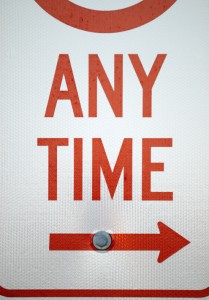When up is Down (Part 5)
By Asher Crispe: September 14, 2012: Category Inspirations, Thought Figures
Kabbalistic Reflections on T.S. Eliot’s Four Quartets
If all time is eternally present
All time is unredeemable.
–T. S. Eliot Burnt Norton I
 Temporal inflections dislocate the tenses of time from their respective time zones. The past casts a shadow on the future and the future wanders into the past. Eventually the breach becomes so extensive that all times dissolve into one. Granting this transtemporal reconfiguration of time, are we not faced with a new set of problems?
Temporal inflections dislocate the tenses of time from their respective time zones. The past casts a shadow on the future and the future wanders into the past. Eventually the breach becomes so extensive that all times dissolve into one. Granting this transtemporal reconfiguration of time, are we not faced with a new set of problems?
In our previous article we pondered what would be required in order to hold on to time, to facilitate the greatest preservation project imaginable, to go beyond finding traces of one tense layered on another toward a full blown networking between times. On the dash board we would then have three equally accessible choices: tap the left button for the past, the middle for the present and the right for the future. Posed outside of this staging of ‘all time’ as ‘eternally present’ our only real choice would be where to focus our consciousness. In other words, our past, present and future as ‘eternally present’ might mean that they always already exist and are predetermined.
Consider a future which is already present–does this not imply that the events that will happen have already happened, that I cannot alter that future? Conversely, if the future does not yet exist, if I cannot access it in the present on account of its not yet being created, then it would seem that I can make it up as I go. Likewise, with having the past here all the time, does that mean that I am fully determined by it? A ‘past’ past or a past lodged in memory would retain some degree of mutability. If so, is Eliot laying out the challenges of time as presence? Perhaps we could understand this opening of Burnt Norton as a critique of the metaphysics of presence which strives for immediate access to meaning, or in this case, for immediate access to the meaning of time. We spin through a revolving door that situates meaningful time within the timing of meaning.
If all of time does not eternally exist, then we can assert the possibility of temporal indeterminism. My past does not exist as it once did, it is subject to archival issues and historiographic concerns and thus it may be changed. We may fill in the blanks. We dialogue with the past and its meaning is stretched between partial historical records and present and future interpretation. So too, my future has yet to be written either by myself or by so called ‘impartial historians’ and futurists. Even if a script for the future pre-exists the future that it was written for, the fact that it has not already been acted out and recorded means that we could always go off script, break protocol and revise that future. Redemption of time can only happen when there is something to make up, a novelty to time, a possibility for exchange. Should I be able to swap out one time line for another, then the meaning of my past, present and future would all shift accordingly. For this to happen a surplus of time needs to be held in infinite reserve. Most importantly, this reserve of time cannot be formally present but must appear to my senses as absent. Creation of something from nothing could then be understood as the birthing of absent possibilities into a ‘con/temporary’ stream of life.
Calling upon the Mittler Rebbe and the Chassidic philosophic tradition once more, we can hyperlink to another of his imposing texts called Imrei Binah (pp.125-128) where he explains the necessity of a twofold sense of time. Here he focuses on the unlimited source of time (mekor hazeman) which maintains an indifference to the arrow of time. Just like the time symmetry that exists within the quantum realm of sub-atomic particles, whereby there is no difference between future and past, the element of time in its source (which means prior to its creation and production for the world and in the world) equalizes ‘before’ and ‘after’ to the extent that no past-future distinction can be made.
Production of a temporal triad follows the same process as the rest of Creation. Lurianic Kabbalah depicts cosmogenesis in terms of a contraction (tzimtzum) of the infinite Divine light in order to give rise to a seemly ‘empty’ space within which to create the world. Alternatively put, the infinite revelation and limitlessness that exists prior to the creation of the world is withdrawn and thereby allows for finite expressions of Divinity to shine through which are constitutive of our universe. The Chassidic masters emphasize that this is but a game of hide and seek. God is still ‘eternally present’ along with all of time in the veil of the void. The only difference is in terms of our consciousness. We only perceive the limitation due to our falling for the illusion of the void or absence. As a result we pick up on discreet time signatures and divide the previously indivisible temporal continuum.
Contraction of infinite time (the source of time) produces the finitude of time (time actualized as the presenting or ‘presencing’ of past, present and future) which leads to the extension and expression of a moment followed by its immediate withdrawal. The Mittler Rebbe likens this to a run and return (ratzo v’shuv) within Creation. The ‘run’ of time is the willing of time into existence while the ‘return’ represents its retraction. This image of a pulsating episodic temporality mirrors our overall oscillation between being and nothingness or the incessant interruption of continuous recreation.
Jewish responses to the quandary posed by Eliot involve sustaining the paradox of both an open and closed, infinite and finite sense of time. This paradox itself may well be the essence of messianic reality as Emmanuel Levinas (Totality and Infinity [pp.284-5]) has so eloquently stated:
“Truth requires both an infinite time and a time it will be able to seal, a completed time. The completion of time is not death, but messianic time, where the perpetual is converted into the eternal. Messianic triumph is the pure triumph; it is secured against the revenge of evil whose return the infinite time does not prohibit. Is this eternity a new structure of time, or an extreme vigilance of the messianic consciousness?”
The ‘perpetual’ fuel injection of discreet instants of time that are immediately burned and get ‘converted into the eternal,’ which experiences the compresence of past, present, and future, would be something akin to a reverse contraction (tzimtzum). Rather than tightening the belt it is loosened or thrown away. Here, Levinas is speaking about a singularity. If the messianic era could be likened to the accelerating returns that speed the exponential growth of technological change, then this singularity would be the event in which the growth becomes so rapid that it would be depicted graphically as asymptotic literally heading off the charts. Thus, Levinas focuses on the critical juncture of a metamorphic reality, the fissure in thought that incited Eliot to write poetry about the poiesis of time. This ethical response is to both save time and to be saved from time.
Would we read Eliot’s words as an affirmation of eternal return in the sense described by Nietzsche, then the problem of redeeming time rests of the assumption that what eternally returns is always the same time. ‘Always the same’ translates as always determined and therefore nonexchangeable. As if to say, ‘live your life as though it is the only life you will have to live and be willing to live it in exactly the same way over and over again.’
Gilles Deleuze however, takes a different approach with Nietzsche (“Active and Reactive” in The New Nietzsche [p.86]) whereby:
“We misconstrue the expression ‘eternal return’ when we take it as the return of the same. It is not being that recurs, but, rather, that recurrence itself constitutes being insofar as it affirms becoming and passing. It is not some one thing that recurs, but that recurrence is itself affirmed by the passage of diversity or multiplicity. In other words, identity in the Eternal Return does not designate the nature of what recurs, but, to the contrary, the fact of recurring difference.”
Thus, the only thing to not changing is change itself. ‘Being’ itself is read as ‘becoming.’ Where do we encounter this in Kabbalah? In Malachi (3:6) we find the expression: “I am God [Tetragrammaton], I have not changed.” Since, we have already elucidated the threefold temporal unity of this name, it would seem that positing the unchanging nature of this name/identity means that even when we experience discreet instants and tenses of time, there nonetheless persists a level in which they are all ‘eternally present.’ Moreover, this name can mean both Havayah or ‘Being’ as well as ‘hithavut’ which means ‘to bring into being.’ Taken in both senses, the semantic force of the name fuses being with becoming. Thus, the ‘eternally present’ situation is change. ‘Constant change’ implies both eternity and temporality together.
 One might imagine an old slide projector with a round wheel of slides representing individual slices of time. They advance in an order and have clear directionality which secures our sense of a before and after. Simultaneously, the entire wheel is present at each and every moment durning the showing of any particular slide. For Deleuze, it is as through the whole wheel gets lifted off its socket and then returned with all the same slices just advanced one position in the projection queue. Because the wheel is one entity, all the slices of time our interconnected even if they are not being shown all at once. Whichever slice is highlighted becomes the focus of our attention and functions as the prism through which we re-experience and re-connect to all of the others. The others are then continually reassessed through the combination of the constantly changing wheel, the lineup of slides and the selected projected slide.
One might imagine an old slide projector with a round wheel of slides representing individual slices of time. They advance in an order and have clear directionality which secures our sense of a before and after. Simultaneously, the entire wheel is present at each and every moment durning the showing of any particular slide. For Deleuze, it is as through the whole wheel gets lifted off its socket and then returned with all the same slices just advanced one position in the projection queue. Because the wheel is one entity, all the slices of time our interconnected even if they are not being shown all at once. Whichever slice is highlighted becomes the focus of our attention and functions as the prism through which we re-experience and re-connect to all of the others. The others are then continually reassessed through the combination of the constantly changing wheel, the lineup of slides and the selected projected slide.
Subsequently, time and eternity call to each other. This is no flirtation. They are engaged to be married in some expected messianic event.
We wish to dedicate this series of articles to the memory and elevation of the soul of Yaakov Ben Tzvi Hersh (Ballan) whose soul should experience the reality where ‘time present and time past’ are both definitely ‘present in time future…May his soul be bound in the bundle of life. –The 5th of Tamuz 5772.
When up is Down (Part 5),























;)
;)
;)
;)
;)
;)
;)
;)
;)
;)
